Modeling Pollutant Emissions: Influence of Two Heat and Power Plants on Urban Air Quality
Abstract
:1. Introduction
2. Analyzed Objects
3. Methodology
4. Results and Discussion
5. Conclusions
Author Contributions
Funding
Institutional Review Board Statement
Informed Consent Statement
Data Availability Statement
Conflicts of Interest
References
- Yang, G.; Wang, Y.; Zeng, Y.; Gao, G.F.; Liang, X.; Zhou, M.; Wan, X.; Yu, S.; Jiang, Y.; Naghavi, M.; et al. Rapid health transition in China, 1990–2010: Findings from the global burden of disease study 2010. Lancet 2013, 381, 1987–2015. [Google Scholar] [CrossRef]
- Sówka, I.; Kobus, D.; Skotak, K.; Zathey, M.; Merenda, B.; Paciorek, M. Assessment of the health risk related to air pollution in selected polish health resorts. J. Ecol. Eng. 2019, 20, 132–145. [Google Scholar] [CrossRef]
- Pope, C.A. Mortality effects of longer term exposures to fine particulate air pollution: Review of recent epidemiological evidence. Inhal. Toxicol. 2007, 19, 33–38. [Google Scholar] [CrossRef] [PubMed]
- Almeida, S.M.; Pio, C.; Freitas, M.; Reis, M.; Trancoso, M. Source apportionment of fine and coarse particulate matter in a sub-urban area at the Western European Coast. Atmospheric. Environ. 2005, 39, 3127–3138. [Google Scholar] [CrossRef]
- UNION, PEAN. Directive 2008/50/EC of the European Parliament and of the Council of 21 May 2008 on ambient air quality and cleaner air for Europe. Off. J. Eur. Union 2008, 29, 169–212. Available online: http://data.europa.eu/eli/dir/2008/50/oj (accessed on 12 June 2021).
- World Health Organization. Who Air Quality Guidelines for Particulate Matter, Ozone, Nitrogen Dioxide and Sulfur Dioxide. Global Update 2005. Summary of Risk Assessment, 2005. Available online: https://www.euro.who.int/en/health-topics/environment-and-health/air-quality/publications/pre2009/air-quality-guidelines.-global-update-2005.-particulate-matter,-ozone,-nitrogen-dioxide-and-sulfur-dioxide (accessed on 12 June 2021).
- Meng, M.; Zhou, J. Has air pollution emission level in the Beijing–Tianjin–Hebei region peaked? A panel data analysis. Ecol. Indic. 2020, 119, 106875. [Google Scholar] [CrossRef]
- World Health Organization. Review of Evidence on Health Aspects of Air Pollution—REVIHAAP Project. World Health Organization 309. 2013. Available online: http://www.euro.who.int/en/health-topics/environment-and-health/air-quality/publications/2013/review-of-evidence-on-health-aspects-of-air-pollution-revihaap-project-finaltechnical-report (accessed on 2 July 2021).
- Larssen, S.; Hagen, O.L. Air Quality in Europe, 1993. A Pilot Report. November 1996. European Environment Agency. Available online: https://www.eea.europa.eu/publications/2-9167-057-X (accessed on 12 June 2021).
- Kousoulidou, M.; Ntziachristos, L.; Mellios, G.; Samaras, Z. Road-transport emission projections to 2020 in European urban environments. Atmospheric. Environ. 2008, 42, 7465–7475. [Google Scholar] [CrossRef]
- Kota, S.; Zhang, H.; Chen, G.; Schade, G.; Ying, Q. Evaluation of on-road vehicle CO and NOx national emission inventories using an urban-scale source-oriented air quality model. Atmospheric. Environ. 2014, 85, 99–108. [Google Scholar] [CrossRef]
- Mohsen, M.; Ahmed, M.B.; Zhou, J.L. Particulate matter concentrations and heavy metal contamination levels in the railway transport system of Sydney, Australia. Transp. Res. Part D Transp. Environ. 2018, 62, 112–124. [Google Scholar] [CrossRef]
- Cichowicz, R.; Wielgosiński, G.; Fetter, W. Effect of wind speed on the level of particulate matter PM10 concentration in atmospheric air during winter season in vicinity of large combustion plant. J. Atmospheric. Chem. 2020, 77, 35–48. [Google Scholar] [CrossRef]
- Cocks, A.T.; Kallend, A.S.; Marsh, A.R.W. Dispersion limitations of oxidation in power plant plumes during long-range transport. Nat. Cell Biol. 1983, 305, 122–123. [Google Scholar] [CrossRef]
- Bednova, O.V.; Kuznetsov, V.A.; Tarasova, N.P. Eutrophication of an urban forest ecosystem: Causes and effects. Dokl. Earth Sci. 2018, 478, 124–128. [Google Scholar] [CrossRef]
- Diamond, M.S.; Wood, R. Limited Regional aerosol and cloud microphysical changes despite unprecedented decline in nitrogen oxide pollution during the February 2020 COVID-19 shutdown in China. Geophys. Res. Lett. 2020, 47, 2020 088913. [Google Scholar] [CrossRef]
- Obolkin, V.; Khodzher, T.; Sorokovikova, L.; Tomberg, I.; Netsvetaeva, O.; Golobokova, L. Effect of long-range transport of sulphur and nitrogen oxides from large coal power plants on acidification of river waters in the Baikal region, East Siberia. Int. J. Environ. Stud. 2016, 73, 452–461. [Google Scholar] [CrossRef]
- Nagl, C.; Spangl, W.; Buxbaum, I. Sampling Points for Air Quality. Representativeness and Comparability of Measurement in Accordance with Directive 2008/50/EC on Ambient Air Quality and Cleaner Air for Europe. Policy Department for Economic, Scientific and Quality of Life Policies, Directorate-General for Internal Policies. PE 631.055-March 2019. Available online: http://www.europarl.europa.eu/RegData/etudes/STUD/2019/631055/IPOL_STU(2019)631055_EN.pdf (accessed on 12 June 2021).
- Chen, W.; Wang, F.; Xiao, G.; Wu, K.; Zhang, S. Air quality of beijing and impacts of the new ambient air quality standard. Atmosphere 2015, 6, 1243–1258. [Google Scholar] [CrossRef] [Green Version]
- Kuklinska, K.; Wolska, L.; Namiesnik, J. Air quality policy in the U.S. and the EU–A review. Atmospheric. Pollut. Res. 2015, 6, 129–137. [Google Scholar] [CrossRef]
- Atamaleki, A.; Zarandi, S.M.; Fakhri, Y.; Mehrizi, E.A.; Hesam, G.; Faramarzi, M.; Darbandi, M. Estimation of air pollutants emission (PM10, CO, SO2 and NOx) during development of the industry using AUSTAL 2000 model: A new method for sustainable development. MethodsX 2019, 6, 1581–1590. [Google Scholar] [CrossRef]
- Cichowicz, R.; Dobrzański, M. 3D spatial analysis of particulate matter (PM10, PM2.5 and PM1.0) and gaseous pollutants (H2S, SO2 and VOC) in urban areas surrounding a large heat and power plant. Energies 2021, 14, 4070. [Google Scholar] [CrossRef]
- Keshavarzian, E.; Jin, R.; Dong, K.; Kwok, K.C. Effect of building cross-section shape on air pollutant dispersion around buildings. Build. Environ. 2021, 197, 107861. [Google Scholar] [CrossRef]
- Ramponi, R.; Blocken, B.; De Coo, L.B.; Janssen, W.D. CFD simulation of outdoor ventilation of generic urban configurations with different urban densities and equal and unequal street widths. Build. Environ. 2015, 92, 152–166. [Google Scholar] [CrossRef] [Green Version]
- Yuan, C.; Ng, E.Y.Y. Building porosity for better urban ventilation in high-density cities–A computational parametric study. Build. Environ. 2012, 50, 176–189. [Google Scholar] [CrossRef]
- Łatuszyńska, M.; Strulak-Wójcikiewicz, R. A model for assessing the environmental impact of transport. Oper. Res. Decis. 2013, 23, 67–80. [Google Scholar] [CrossRef]
- Abu-Allaban, M.; Abu-Qdais, H. Impact assessment of ambient air quality by cement industry: A case study in jordan. Aerosol Air Qual. Res. 2011, 11, 802–810. [Google Scholar] [CrossRef]
- Paas, B.; Schneider, C. A comparison of model performance between ENVI-met and Austal2000 for particulate matter. Atmospheric. Environ. 2016, 145, 392–404. [Google Scholar] [CrossRef]
- Ropkins, K.; Beebe, J.; Li, H.; Daham, B.; Tate, J.; Bell, M.; Andrews, G. Real-world vehicle exhaust emissions monitoring: Review and critical discussion. Crit. Rev. Environ. Sci. Technol. 2009, 39, 79–152. [Google Scholar] [CrossRef]
- Gebremedhin, A. Introducing district heating in a norwegian town–potential for reduced local and global emissions. Appl. Energy 2012, 95, 300–304. [Google Scholar] [CrossRef]
- Cichowicz, R.; Dobrzański, M. Spatial analysis (measurements at heights of 10 m and 20 m above ground level) of the concentrations of particulate matter (PM 10, PM 2.5, and PM 1.0) and gaseous pollutants (H2S) on the university campus: A case study. Atmosphere 2021, 12, 62. [Google Scholar] [CrossRef]
- Lee, H.; Yoo, J.; Kang, M.; Kang, J.; Jung, J.; Oh, K. Evaluation of concentrations and source contribution of PM 10 and SO2 emitted from industrial complexes in Ulsan, Korea: Interfacing of the WRF–CALPUFF modeling tools. Atmospheric. Pollut. Res. 2014, 5, 664–676. [Google Scholar] [CrossRef] [Green Version]
- Hao, J.; Wang, L.; Shen, M.; Li, L.; Hu, J. Air quality impacts of power plant emissions in Beijing. Environ. Pollut. 2007, 147, 401–408. [Google Scholar] [CrossRef]
- Calculation Software for Pollutant Concentration Analysis. Eko-Soft company from Poland. Available online: http://www.eko-soft.com.pl/sysopa.htm (accessed on 12 June 2021).
- Polish Legal Act. Rozporządzenie Ministra Środowiska z Dnia 26 Stycznia 2010 r. w Sprawie Wartości Odniesienia Dla Niektórych Substancji W Powietrzu. Available online: http://isap.sejm.gov.pl/isap.nsf/DocDetails.xsp?id=wdu20100160087 (accessed on 12 June 2021).
- Meteorological Data. Available online: https://danepubliczne.imgw.pl/data/dane_pomiarowo_obserwacyjne/dane_meteorologiczne/miesieczne/synop/2019/ (accessed on 12 June 2021).
- Jumaah, H.; Kalantar, B.; Halin, A.; Mansor, S.; Ueda, N.; Jumaah, S. Development of UAV-based PM2.5 monitoring system. Drones 2021, 5, 60. [Google Scholar] [CrossRef]
- Caillouet, C.; Giroire, F.; Razafindralambo, T. Optimization of mobile sensor coverage with UAVs. In Proceedings of the IEEE INFOCOM 2018-IEEE Conference on Computer Communications, Honolulu, HI, USA, 15–19 April 2018; pp. 622–627. [Google Scholar]
- Ghermandi, G.; Fabbi, S.; Arvani, B.; Veratti, G.; Bigi, A.; Teggi, S. Impact assessment of pollutant emissions in the atmosphere from a power plant over a complex terrain and under unsteady winds. Sustainability 2017, 9, 2076. [Google Scholar] [CrossRef] [Green Version]
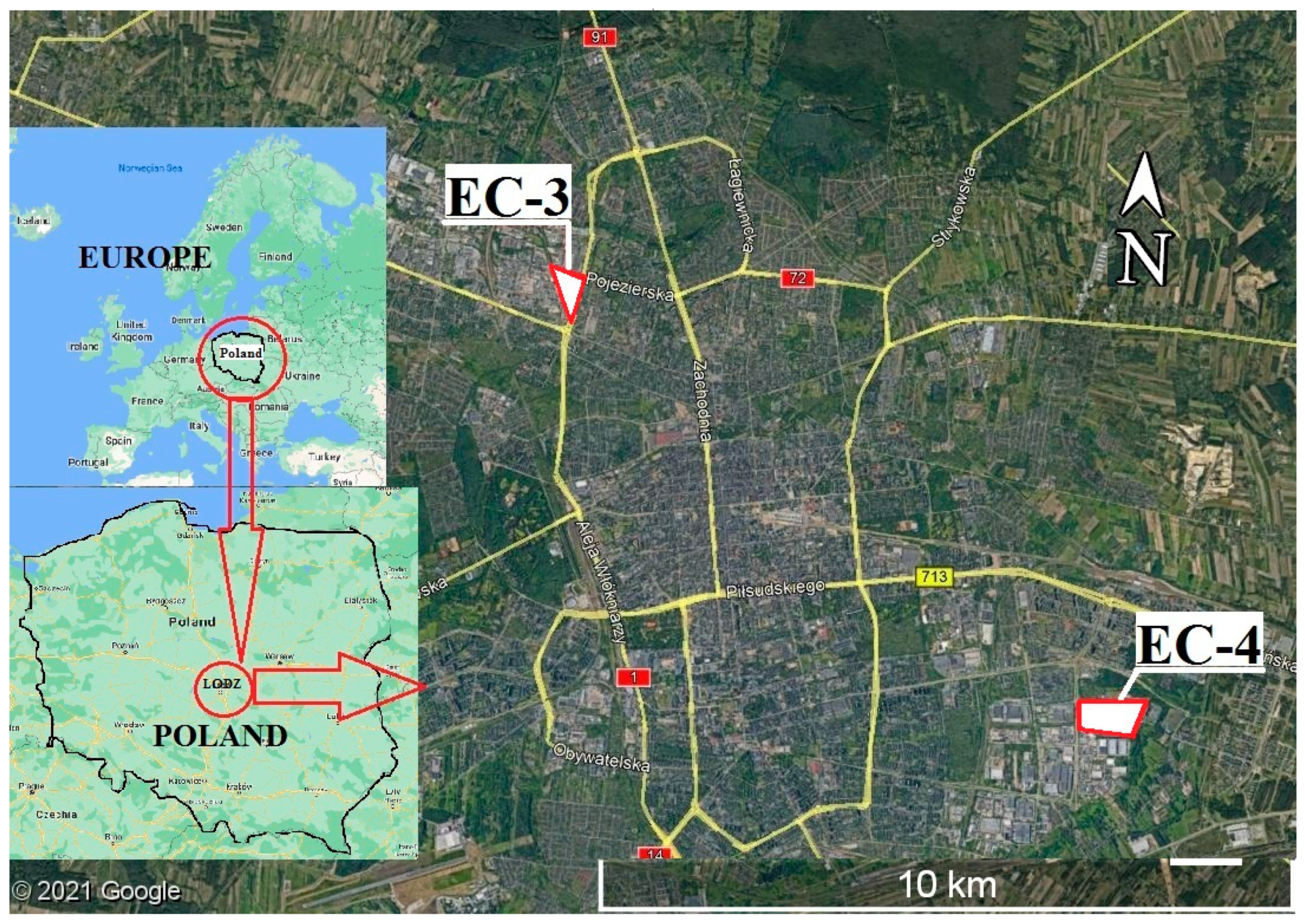


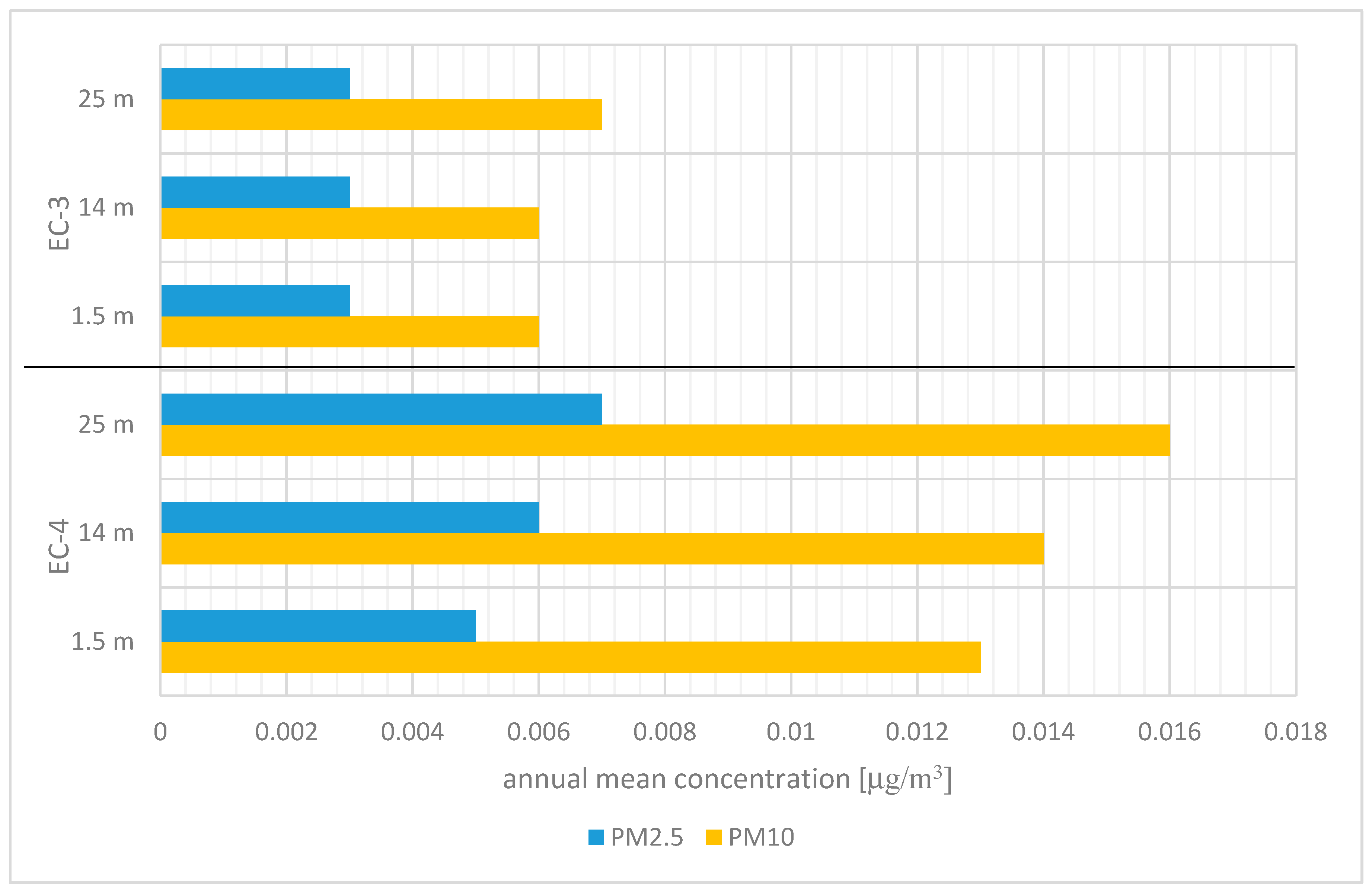


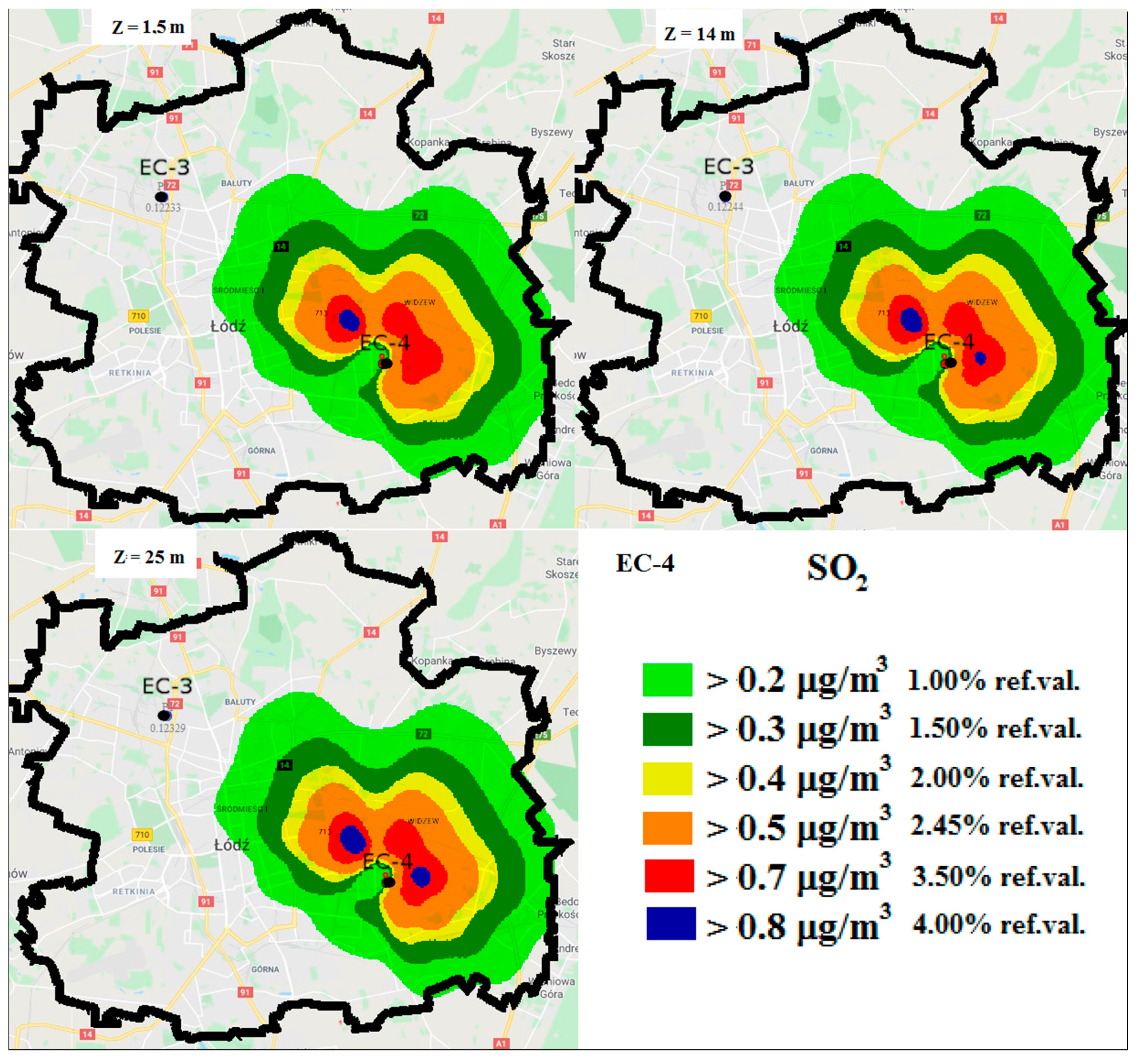
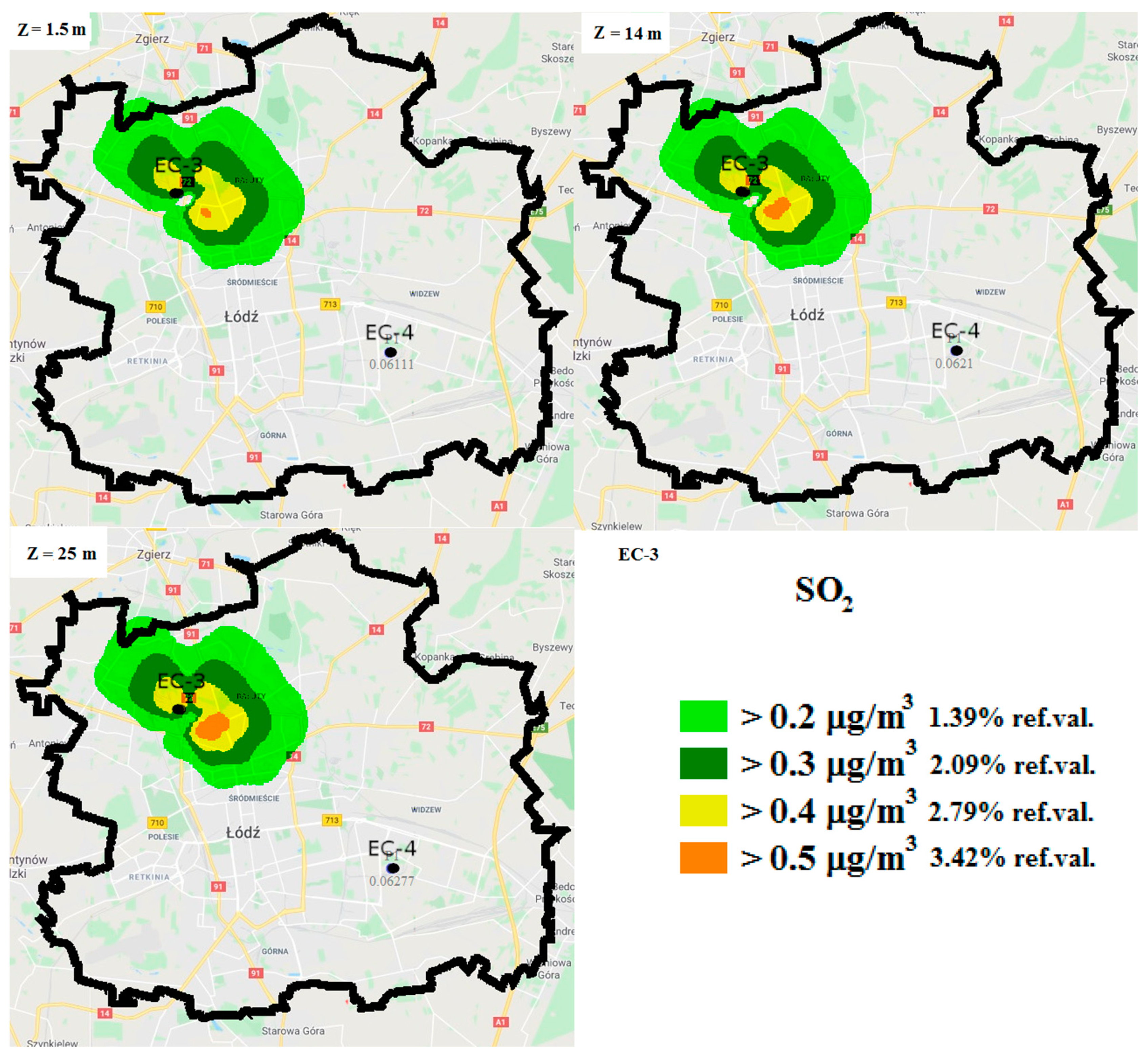


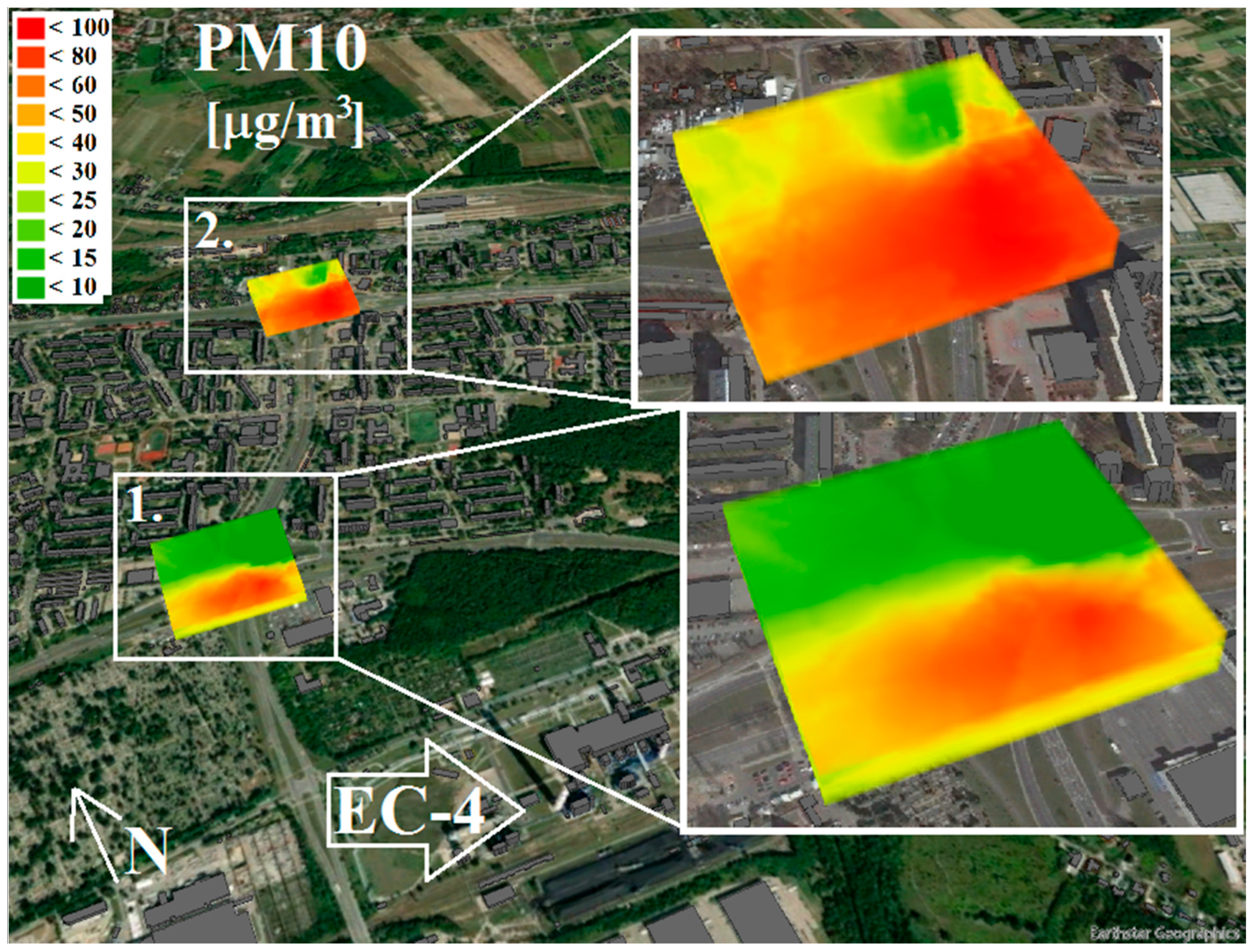
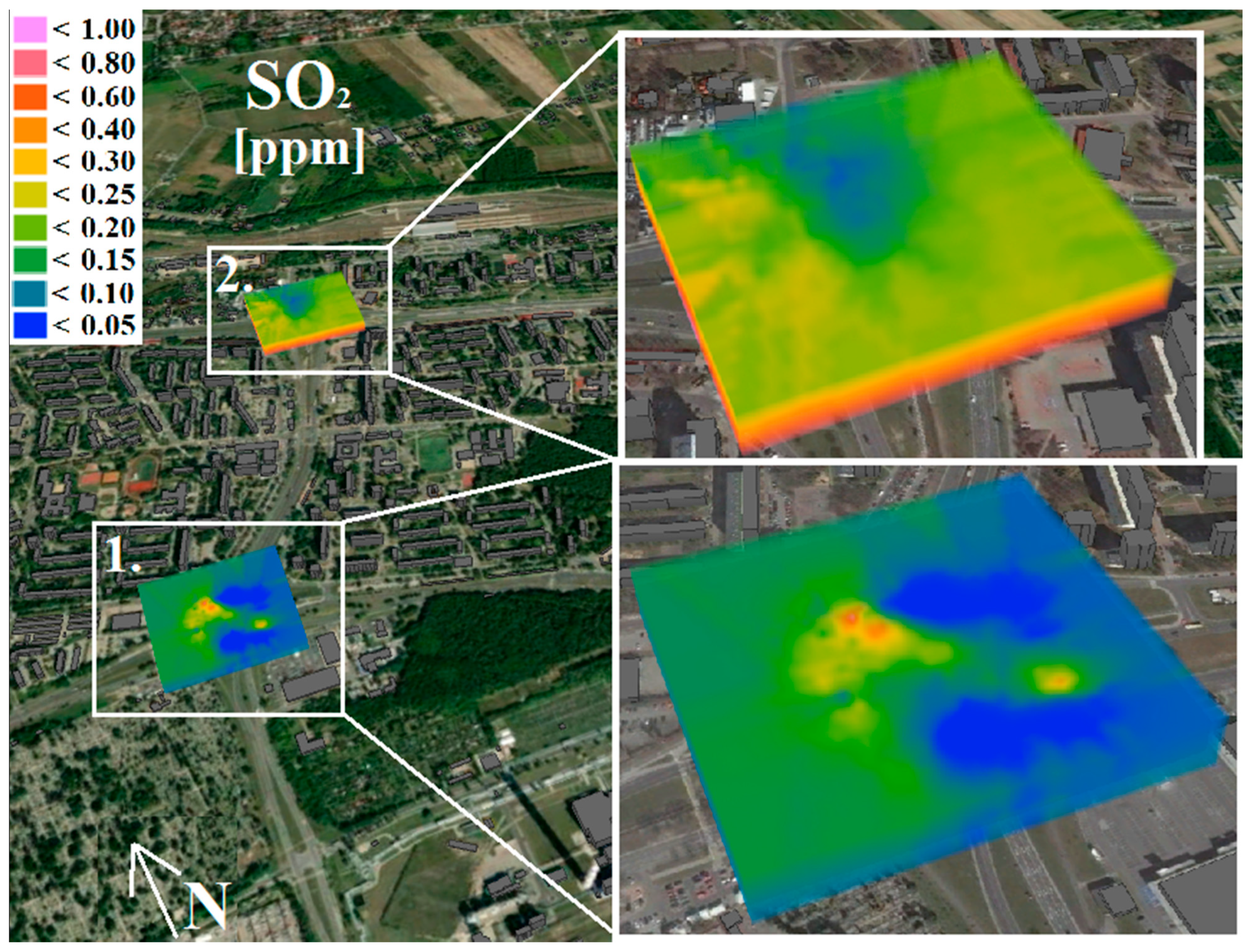
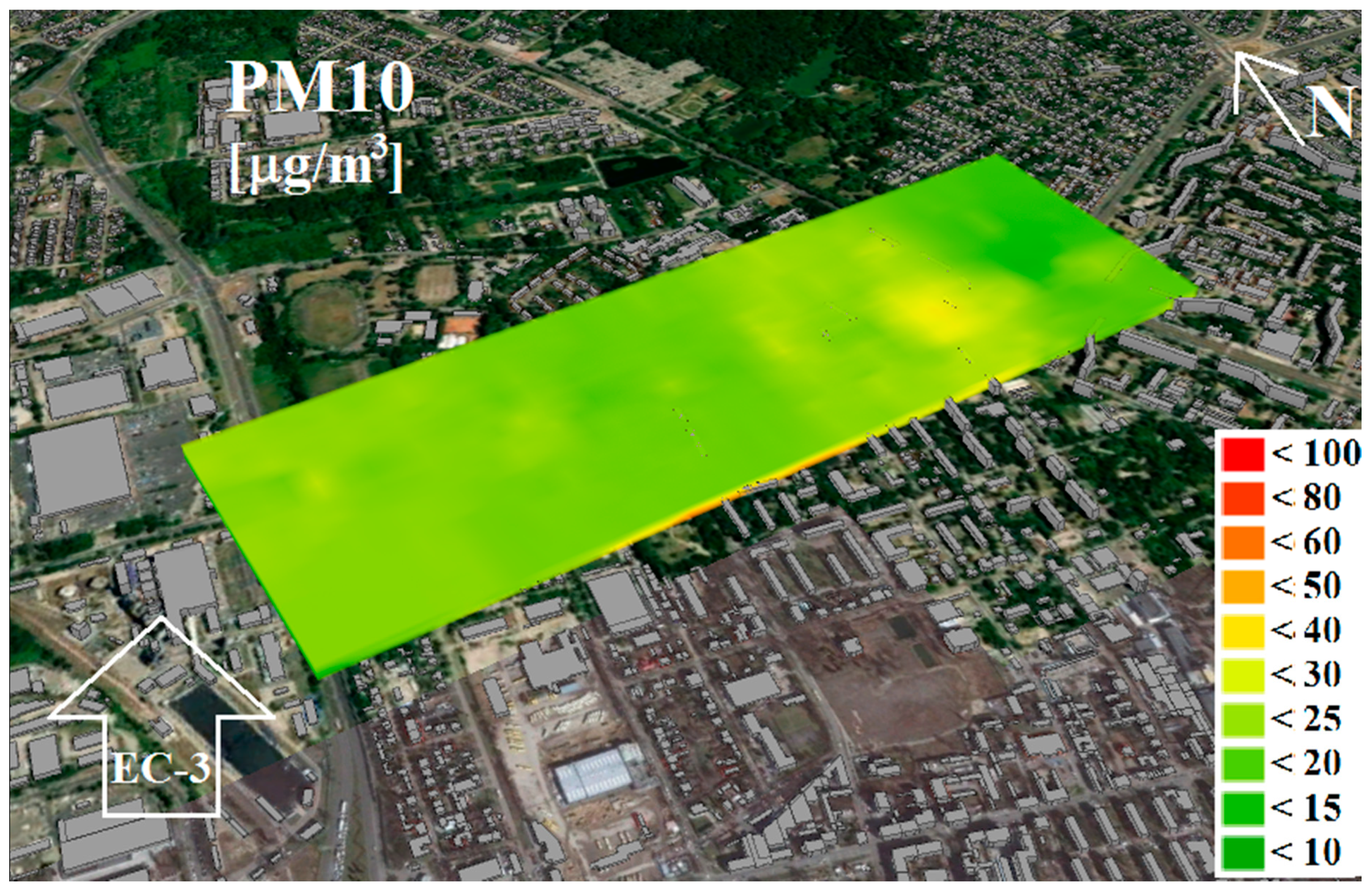

| Month | January | February | March | April | May | June |
| Temperature [°C] | −1.7 | 2.6 | 5.7 | 10.1 | 12.4 | 22.2 |
| Month | July | August | September | October | November | December |
| Temperature [°C] | 18.7 | 20.2 | 14.0 | 10.4 | 6.2 | 3.2 |
| EC-3 CHP Plant | ||||
|---|---|---|---|---|
| Emitor: | Emission [kg] | |||
| PM10 | PM2.5 | SO2 | NO2 | |
| H120-K1, K2, K3, K6, K9 | 11,080.37 | 4748.73 | 578,788.3 | 583,515.8 |
| EC-4 CHP Plant | ||||
| H250-K7 | 10,645.88 | 4562.52 | 228,952.5 | 300,471.9 |
| H200-K2 | 4783.52 | 2050.08 | 135,430.6 | 151,654.8 |
| H200-K3 | 3286.64 | 1408.56 | 72,609.9 | 171,419.2 |
| H200-K4, K5 | 1267.21 | 543.09 | 46,013.7 | 29,063.1 |
| H200-K6 | 808.78 | 346.62 | 26,176.0 | 14,290.0 |
| EC-3 CHP Plant | ||||
|---|---|---|---|---|
| Emitor | Maximum Hourly Emission [kg/h] | |||
| H120 | PM10 | PM2.5 | SO2 | NO2 |
| 2.667 | 1.143 | 128.81 | 144.20 | |
| EC-4 CHP Plant | ||||
| PM10 | PM2.5 | SO2 | NO2 | |
| H250-K7 | 4.760 | 2.040 | 103.40 | 79.30 |
| H200-K2 | 3.430 | 1.470 | 189.90 | 48.96 |
| H200-K3 | 0.896 | 0.384 | 24.12 | 34.49 |
| H200-K4, K5 | 6.286 | 2.694 | 122.83 | 86.70 |
| H200-K6 | 8.085 | 3.465 | 285.95 | 145.7 |
| EC-3 CHP Plant | |||||
|---|---|---|---|---|---|
| Emitor: | Period: | Average Hour Emission [kg/h] | |||
| PM10 | PM2.5 | SO2 | NO2 | ||
| H120-K1, K2, K3, K6, K9 | Summer period | 0.91 | 0.39 | 34.65 | 34.80 |
| I Winter-heating period | 2.317 | 0.993 | 113.38 | 124.37 | |
| II Winter-heating period | 1.316 | 0.564 | 96.46 | 87.61 | |
| EC-4 CHP Plant | |||||
| H250-K7 | Summer period | 2.31 | 0.99 | 45.63 | 63.50 |
| I Winter-heating period | 2.611 | 1.119 | 50.16 | 62.37 | |
| II Winter-heating period | 1.806 | 0.774 | 48.14 | 65.41 | |
| H200-K2 | Summer period | 0.896 | 0.384 | 21.27 | 30.49 |
| I Winter-heating period | 1.302 | 0.558 | 26.78 | 36.6 | |
| II Winter-heating period | 0.945 | 0.405 | 55.96 | 37.11 | |
| H200-K3 | Summer period | 0.434 | 0.186 | 9.59 | 21.17 |
| I Winter-heating period | 0.42 | 0.18 | 11.44 | 28.87 | |
| II Winter-heating period | 0.553 | 0.237 | 10.33 | 24.88 | |
| H200-K4, K5 | Summer period | 0.931 | 0.399 | 38.37 | 23.31 |
| I Winter-heating period | 2.324 | 0.996 | 73.62 | 45.56 | |
| II Winter-heating period | 1.323 | 0.567 | 54.85 | 36.18 | |
| H200-K6 | Summer period | 1.204 | 0.516 | 69.36 | 57.6 |
| I Winter-heating period | 3.206 | 1.374 | 87.05 | 45.3 | |
| II Winter-heating period | 1.491 | 0.639 | 91.09 | 54.41 | |
Publisher’s Note: MDPI stays neutral with regard to jurisdictional claims in published maps and institutional affiliations. |
© 2021 by the authors. Licensee MDPI, Basel, Switzerland. This article is an open access article distributed under the terms and conditions of the Creative Commons Attribution (CC BY) license (https://creativecommons.org/licenses/by/4.0/).
Share and Cite
Cichowicz, R.; Dobrzański, M. Modeling Pollutant Emissions: Influence of Two Heat and Power Plants on Urban Air Quality. Energies 2021, 14, 5218. https://doi.org/10.3390/en14175218
Cichowicz R, Dobrzański M. Modeling Pollutant Emissions: Influence of Two Heat and Power Plants on Urban Air Quality. Energies. 2021; 14(17):5218. https://doi.org/10.3390/en14175218
Chicago/Turabian StyleCichowicz, Robert, and Maciej Dobrzański. 2021. "Modeling Pollutant Emissions: Influence of Two Heat and Power Plants on Urban Air Quality" Energies 14, no. 17: 5218. https://doi.org/10.3390/en14175218
APA StyleCichowicz, R., & Dobrzański, M. (2021). Modeling Pollutant Emissions: Influence of Two Heat and Power Plants on Urban Air Quality. Energies, 14(17), 5218. https://doi.org/10.3390/en14175218







